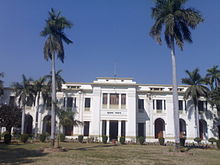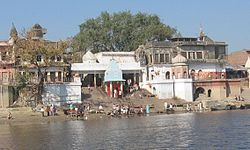GD Classes
No.1 Instituite For IIT-JEE (Mains & Advance) / NEET
 Kanpur, spelled as Cawnpore before 1948, is the tenth most populous city in India and the largest within the state of Uttar Pradesh. It is the largest city of the Hindi-speaking belt after Delhi. It remains one of the oldest industrial townships of North India, although it has not kept pace with IT industry growth in the rest of India due to political indifference. It is situated on the most important national highways no. 2 & 25 and state highway. It is also situated on the main Delhi-Howrah railway trunck line. It is situated on bank of holy river Ganga and is about 126 meters above the sea level. Presently civilian air-service available for the city.A 9,000 feet air strip is available at civilian air terminal Chakeri (Ahirwan). The nearest International air port Amausi (Lucknow) is 65Km. away from Kanpur.
Kanpur, spelled as Cawnpore before 1948, is the tenth most populous city in India and the largest within the state of Uttar Pradesh. It is the largest city of the Hindi-speaking belt after Delhi. It remains one of the oldest industrial townships of North India, although it has not kept pace with IT industry growth in the rest of India due to political indifference. It is situated on the most important national highways no. 2 & 25 and state highway. It is also situated on the main Delhi-Howrah railway trunck line. It is situated on bank of holy river Ganga and is about 126 meters above the sea level. Presently civilian air-service available for the city.A 9,000 feet air strip is available at civilian air terminal Chakeri (Ahirwan). The nearest International air port Amausi (Lucknow) is 65Km. away from Kanpur.
Nestled on the banks of the river Ganga, Kanpur stands as one of North India’s major industrial centres with its own historical, religious and commercial importance. It is believed to have been founded by Hindu Chandel King of the state of Sachendi. The city's name is believed to have been derived from Kanhiyapur, the town of Kanhiya (Lord Krishna). In the course of time, Kanhiyapur probably was abbreviated as Kanhapur and subsequently as Kanpur. "Cawnpore" was the Anglicized spelling of the name during the British Raj.
Others believe that the name is derived from Karnapur and is associated with Karna, one of the heroes of the Mahabharata. Duryodhana made Karna a king, seeing him as a fitting match to Arjuna, and granted him this area; the region was named after its first king. Another theory is that it came from the nearby town of Makanpur, earlier known as Khairabad, where the Sufi saint of the Madariya Sufi order, Badiuddin Zinda Shah Madar (d. 1434 CE), settled. Historically, Jajmau, on the eastern outskirts of present day Kanpur, is regarded as one of the original settlements in the Kanpur district.
 IIT Kanpur was established by an Act of Parliament in 1959. The institute was started in December 1959 in a room in the canteen building of the Harcourt Butler Technological Institute at Agricultural Gardens in Kanpur. In 1963, the institute moved to its present location, on the Grand Trunk Road near the village of Kalyanpur in Kanpur district.
IIT Kanpur was established by an Act of Parliament in 1959. The institute was started in December 1959 in a room in the canteen building of the Harcourt Butler Technological Institute at Agricultural Gardens in Kanpur. In 1963, the institute moved to its present location, on the Grand Trunk Road near the village of Kalyanpur in Kanpur district.
During the first ten years of its existence, IIT Kanpur benefited from the Kanpur Indo-American Programme (KIAP), where a consortium of nine US universities (namely M.I.T, University of California, Berkeley, California Institute of Technology, Princeton University, Carnegie Institute of Technology, University of Michigan, Ohio State University, Case Institute of Technology and Purdue University) helped set up the research laboratories and academic programmes.[2] The first Director of the Institute was P. K. Kelkar (after whom the Central Library was renamed in 2002).
IIT Kanpur is located on the Grand Trunk Road, 15 kilometres (9.3 mi) west of Kanpur City and measures close to 420 hectares (1,000 acres). The campus can be reached from Lucknow airport in two hours. IIT Kanpur is about 16 kilometres (9.9 mi) from the Kanpur Central Railway Station. This land was gifted by the Government of Uttar Pradesh in 1960 and by March 1963 the Institute had moved to its current location.
 Harcourt Butler Technological Institute, Kanpur is an academic autonomous engineering college under the Gautam Buddha Technical University(formerly Uttar Pradesh Technical University). Its programs have been conferred autonomous status under the university.[1] It is the second engineering institute in Uttar Pradesh after the former University of Roorkee. The institute holds ISO 9001:2000 Certification. It offers Bachelors, Masters, and Doctoral degrees in engineering, as well as Masters degrees in Business administration and Computer Applications.
Harcourt Butler Technological Institute, Kanpur is an academic autonomous engineering college under the Gautam Buddha Technical University(formerly Uttar Pradesh Technical University). Its programs have been conferred autonomous status under the university.[1] It is the second engineering institute in Uttar Pradesh after the former University of Roorkee. The institute holds ISO 9001:2000 Certification. It offers Bachelors, Masters, and Doctoral degrees in engineering, as well as Masters degrees in Business administration and Computer Applications.
The history of Harcourt Butler Technological Institute Kanpur, dates back to the 1920s when there was a growing realization of the need for advancement in science and technology among the people of what was then called the United Provinces.Consequently,the Indian Industrial Commission at its Nainital meeting proposed two institutions for engineering — one at Roorkee and the other at Kanpur. To boost entrepreneurship, accelerate industrial development, to create a sound environment for contemporary applied research and to inculcate scientific and technical temper, an Institute called `Government Research Institute, Cawnpore' was started in 1920.
The National Sugar Institute (NSI) established in 1936, is involved in research, training and advisory services to the sugar and allied industry, and functions under the Department of Food and Public Distribution of the Ministry of Consumer Affairs, Food and Public Distribution. Located in Kalyanpur, Kanpur, Uttar Pradesh, India, it provides technical education and training in research in all branches of sugar chemistry, sugar technology, sugar engineering and allied fields. The institute provide assistance to central and state Governments in matters relating to sugar and allied industries.
Established in 1936 by taking over the sugar section of Harcourt Butler Technological Institute, Kanpur as the Imperial Institute of Sugar Technology. The IIST was placed under the administrative control of the Imperial Council of Agricultural Research but continued to be housed in the building of the HBTI.
In 1944, with the formation of the Indian Central Sugarcane Committee, the administrative control of the IIST was transferred to that committee. After the independence of India, the name of the institute was changed to the Indian Institute of Sugar Technology.
From 1st January, 1954 the administrative control of the institute was transferred to the Government of India, Ministry of Food and Agriculture. In 1957, the name of the institute was again changed, to National Sugar Institute (NSI). In 1963, The institute shifted from the HBTI premises to its present premises in Kalyanpur.
 The JK Temple is a temple in the Indian city of Kanpur. Considered to be a unique blend of ancient and modern architecture, its mandapas have been constructed with high roof for adequate ventilation of light and air. The J. K. Trust has constructed this temple.
The JK Temple is a temple in the Indian city of Kanpur. Considered to be a unique blend of ancient and modern architecture, its mandapas have been constructed with high roof for adequate ventilation of light and air. The J. K. Trust has constructed this temple.
Beautifully constructed, J.K. temple is a boon to the devotees. Built by J.K. Trust this architectural delight is a unique blend of ancient architecture with the modern. The even-level roofs o the mandaps have been provided with adequate ventilation for sufficient light and air. Among the five shrines that the temple has the central one s consecrated to Shri Radhakrishna and the other are adorned with idols of Shri Laxminarayan, Shri. Ardhanarishwar, Shri Narmadeshwar and Shri Hanuman.There is park and beautiful lake near the temple which looks beautifully in Night when lights are on.
 The place was known as Brahmavart due to its connection with Brahma the Creator. Brahmavart literally means Lord Brahma's yagna (sacred fire rite) area. It is said that Brahma performed a vast yagna at this place. Designating it as the center of the Universe, he started the creation of humankind from this point. On the Brahmavart Ghat, one of Bithoor's 42 surviving ghats, is a place called Brahmavart Ki Khoonti. It is widely believed that the khoonti is the nail that was once a part of Lord Brahma's wooden slippers (kharaun).
The place was known as Brahmavart due to its connection with Brahma the Creator. Brahmavart literally means Lord Brahma's yagna (sacred fire rite) area. It is said that Brahma performed a vast yagna at this place. Designating it as the center of the Universe, he started the creation of humankind from this point. On the Brahmavart Ghat, one of Bithoor's 42 surviving ghats, is a place called Brahmavart Ki Khoonti. It is widely believed that the khoonti is the nail that was once a part of Lord Brahma's wooden slippers (kharaun).
There are many views as to how it came to be known as Bithoor. The most plausible one relates to Bajirao Peshwa of Maharashtra who had made Bithoor his home after being expelled from Satara by the British. The Peshwa was a devotee of Lord Bithoba. He built a temple dedicated to the Lord and renamed Brahmavart as Bithoba Nagar. Over a period, Bithoba Nagar came to be called Bithoor.
Valmiki Ashram Some of the most significant moments of Hindu religion and mythology are said to be created here, as being the place of the forest-rendezvous of Sita after Lord Rama left her, the birth-place of Lavand Kush, the site where the Ramayana was written. Located at a height, one has to climb some stairs, known as 'stairway to heaven', to arrive at the Ashram, from where a panoramic view of Bithoor spreads out.
Brahmavart Ghat This is the holiest of the holy ghats of Bithoor, where the disciples of Lord Brahma pray at the alter of the 'Wooden Slippers' after a ritual bath. Patthar Ghat The redstone ghat whose foundation stone was laid by the minister of Avadh, Tikait Rai, is a symbol of incomparable art and architecture. There is a massive Shiv temple where the Shivling is made of 'Kasaauti' stone.
Dhruva Teela This is the fabled spot where the child Dhruv meditated single-mindedly on one leg. God was so pleased that he not only appeared but granted him a divine boon--to shine for all time to come as a star.
 The JK Temple is a temple in the Indian city of Kanpur. Considered to be a unique blend of ancient and modern architecture, its mandapas have been constructed with high roof for adequate ventilation of light and air. The J. K. Trust has constructed this temple.
The JK Temple is a temple in the Indian city of Kanpur. Considered to be a unique blend of ancient and modern architecture, its mandapas have been constructed with high roof for adequate ventilation of light and air. The J. K. Trust has constructed this temple.
Beautifully constructed, J.K. temple is a boon to the devotees. Built by J.K. Trust this architectural delight is a unique blend of ancient architecture with the modern. The even-level roofs o the mandaps have been provided with adequate ventilation for sufficient light and air. Among the five shrines that the temple has the central one s consecrated to Shri Radhakrishna and the other are adorned with idols of Shri Laxminarayan, Shri. Ardhanarishwar, Shri Narmadeshwar and Shri Hanuman.There is park and beautiful lake near the temple which looks beautifully in Night when lights are on.
Allen Forest Zoo (also called the Kanpur Zoo) is a zoo in Kanpur, the industrial hub of Uttar Pradesh in North India. It is the largest open green space in Kanpur. Originally a natural habitat for fauna, it is one of the few zoos in India which were created in a natural forest.
The Allen Forest Zoo is located about two kilometers from the city’s center. In earlier colonial records it is mentioned as being close to Nawabganj, some distance away from Bithoor. The zoo is an oasis of green, a natural lake, and ancient trees, and encompasses the largest land area of any zoological garden in Asia.
This ashram belongs to the Sant Shri Shudhanshu Ji Maharaj. Ashram is approx. 6 km away from the Kalyanpur station on the road from Kalyan Pur station to Bithoor.